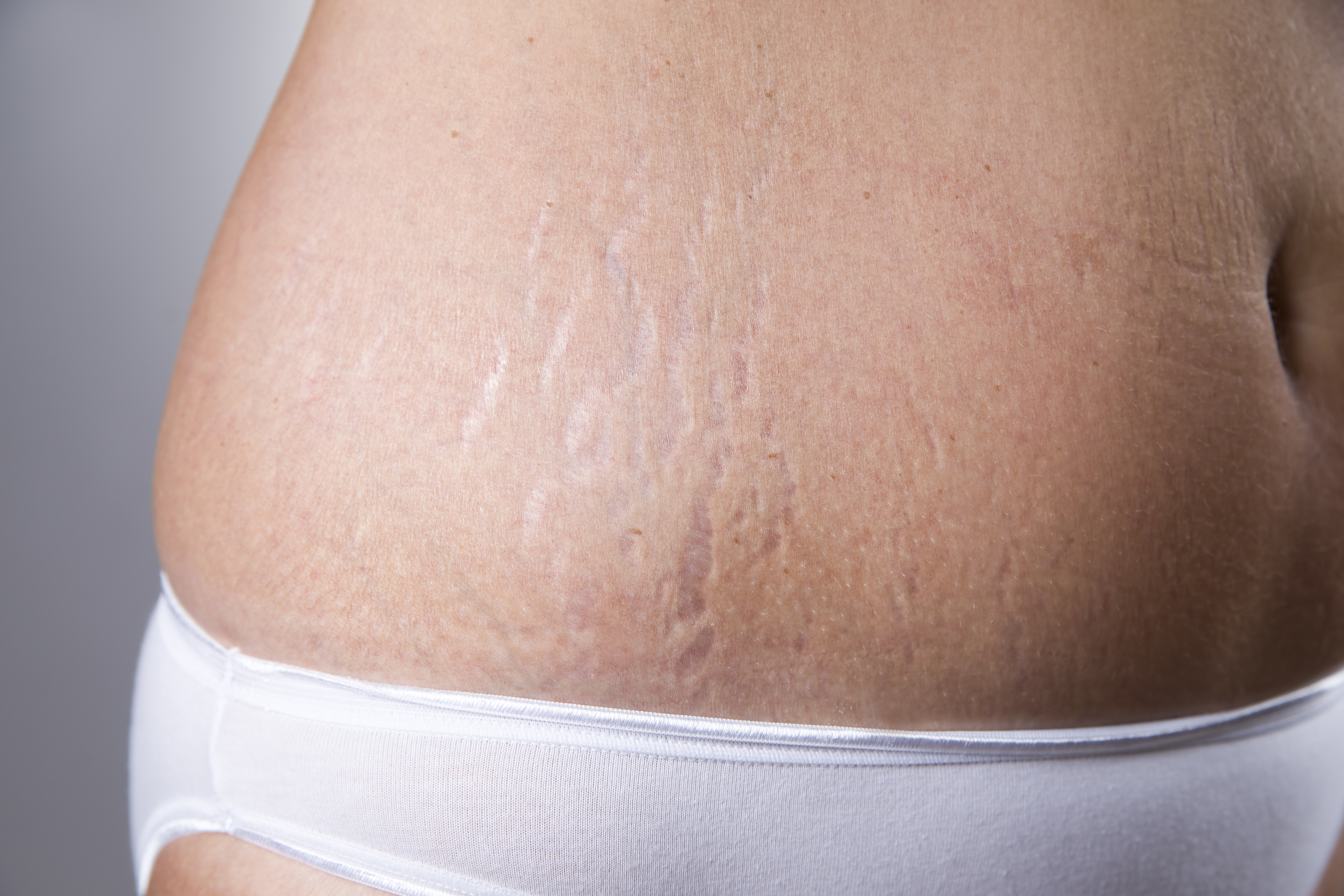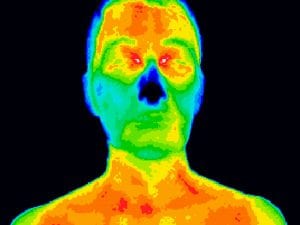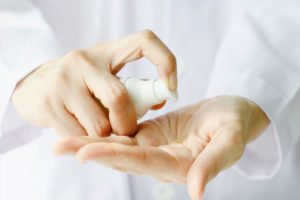Striae distensae (SD) or stretch marks are long, narrow lines or streaks that develop on the skin and look different from the surrounding skin. Stretch marks are very common and may or may not disappear. Although they tend to affect mostly women, men can develop stretch marks as well. The occurrence of striae distensae is not well understood and is likely multifactorial. Physical factors resulting in increased tension on the skin, intrinsic alterations in skin structure or function, and hormonal factors may be involved.
The marks happen when the skin loses elasticity following a period of intense growth or sudden stretching of the skin, which might be the result of pregnancy, weight gain or extreme weight loss, onset of puberty, medical conditions or therapeutic interventions. They form in the middle layer of the skin (the dermis), where the constant stretch causes the dermis to tear and the deeper skin layers to show through, forming the striae. Stretch marks are red or purple initially (striae rubra) due to blood vessels showing through the tears in the dermis. Eventually, they fade to a silvery, white or glossy appearance (striae alba) due to the blood vessels contracting and the pale fat underneath the skin becoming visible. Stretch marks commonly develop on body parts such as the tummy, thighs, hips, breasts, upper arms, and lower back.
INCIDENCE
There is limited epidemiologic data on striae distensae in the general population. Reported incidences have ranged from as low as 11 percent in normal men to up to 88 percent in pregnant females. Striae gravidarum (SG) are specifically defined as the stretch marks developing during pregnancy. Studies specifically exploring risk factors for striae gravidarum suggest that they occur more frequently in women with a family history of SG; higher pre-pregnancy body mass index (BMI); higher weight gain during pregnancy; higher birth weight and gestational age; polyhydramnios; multiple gestation pregnancies. Interestingly, increased maternal age seems to protect against striae gravidarum, suggesting differences in stretching ability between older and younger skin. In fact, a series of examinations post-partum on first time mothers revealed that 84 percent of 51 women under age 20 developed striae gravidarum compared with only 24 percent of 195 women age 30 or older.
While not medically dangerous, SG can be a source of significant anxiety for women, impacting on their quality of life.
PREVENTION
Interventions for the prevention of striae distensae are mostly discussed in the context of pregnancy given the common and expected occurrence of striae distensae in pregnant women. Although many women use a wide variety of creams, lotions, and ointments in attempts to reduce risk for striae development, there is no strong evidence to confirm efficacy of any of these interventions.
A 2012 systematic review by the Cochrane Library involving randomised trials conducted on different products (1. olive oil; 2. cocoa butter; 3. a product containing hyaluronic acid, vitamins A and E, allantoin, and calcium pantothenate; 4. a product containing Centella asiatica extract, alpha tocopherol, and collagen-elastin hydrolysates; and 5. a product containing vitamin E, essential free fatty acids, panthenol, hyaluronic acid, elastin and menthol), found no high-quality evidence to support the use of these topical preparations to prevent striae distensae during pregnancy. In addition, a subsequent randomised trial (n = 360) comparing use of olive oil or a cream containing lanolin, stearin, triethanolamine, almond oil, and bizovax glycerin amidine to no treatment, found that neither intervention was effective for prevention.
Interestingly, a study aiming to identify the effect of applying bitter almond oil with and without massage for preventing stretch marks during pregnancy, found that a 15-minute massage applied with almond oil during pregnancy reduced the development of stretch marks. Applying bitter almond oil without massage had no apparent effect, however. These findings led the authors of this study to conclude that those who are pregnant should be informed of the positive effects of massaging in early in pregnancy, which may in fact be more beneficial than the massage product itself.
TREATMENT
For patients who desire to treat stretch marks, treatment can be challenging. The goal of treatment is to reduce colour or texture discrepancies between striae and adjacent normal skin. No therapeutic intervention has been shown to provide complete resolution of stretch marks. However, clinical findings have shown that interventions such as pulsed dye lasers, fractional lasers and topical tretinoin may have some benefits.
Treatment results are unpredictable and vary from no improvement to significant improvement in patients treated with similar regimens. For these reasons, expectations for treatment outcome and potential adverse effects should be thoroughly discussed with patients prior to the initiation of treatment. In particular, patients with darker skin (Fitzpatrick skin phototypes IV to VI) are at increased risk for ‘dyspigmentation’ after laser treatment. Overall, strict adherence to sun-protective measures is recommended after laser therapy to reduce risk of ‘dyspigmentation’.
In pregnant women, treatment of striae distensae is usually deferred until after delivery because of concerns regarding the effects of various therapies on the unborn baby. Topical tretinoin may be effective against stretchmarks; however, adherence to several months of daily application is usually required and skin irritation is common. Moreover, topical retinoid therapy must be avoided during pregnancy and breastfeeding due to known teratogenic effects.
SUMMARY
Stretch marks may affect both men and women. In women, they commonly develop during pregnancy, particularly in the third trimester. Marks do not disappear entirely, therefore in most cases a person learns to accept them as part of his/her appearance and in some cases embrace them as a sign of endurance. However, any treatment which prevents their development would be welcomed by many. In an independent review of the scientific literature, it was noted that reliable methods for preventing stretch marks are scarce. The Cochrane review concludes that there is limited evidence at present that certain topical preparations may prevent stretch marks and/or reduce their severity. Available topical preparations are lacking support by strong evidence from rigorous, well-designed, randomized controlled trials with sufficient numbers of subjects. Therefore, further research is necessary to investigate the effective prevention and treatment of stretch marks.
References:
- Hannah Nichols; What are stretch marks? How can stretch marks be treated?; http://www.medicalnewstoday.com/articles/283651.php
- Jennifer L MacGregor, MD, Naissan O Wesley, MD; Striae distensae (stretch marks); http://www.uptodate.com/contents/striae-distensae-stretch-marks#H2012647084
- Picard D, Sellier S, Houivet E, Marpeau L, Fournet P, Thobois B, Bénichou J, Joly P; Incidence and risk factors for striae gravidarum; J Am Acad Dermatol. 2015 Oct;73(4):699-700
- Brennan M, Young G, Devane D; Topical preparations for preventing stretch marks in pregnancy; Cochrane Database of Systematic Reviews 2012, Issue 11. Art. No.: CD000066. DOI: 10.1002/14651858.CD000066.pub2
- Korgavkar K1, Wang F; Stretch marks during pregnancy: a review of topical prevention; Br J Dermatol. 2015 Mar; 172(3):606-15. doi: 10.1111/bjd.13426. Epub 2015 Feb 8
- Soltanipour F, Delaram M, Taavoni S, Haghani H; The effect of olive oil and the Saj®cream in prevention of striae gravidarum: A randomized controlled clinical trial; Complement Ther Med. 2014 Apr;22(2):220-5. Epub 2014 Jan 31
- Sermin Timur Taşhan, Ayşe Kafkasli; The effect of bitter almond oil and massaging on striae gravidarum in primiparaous women; J Clin Nurs. 2012 Jun;21(11-12):1570-6. doi: 10.1111/j.1365-2702.2012.04087.x.




